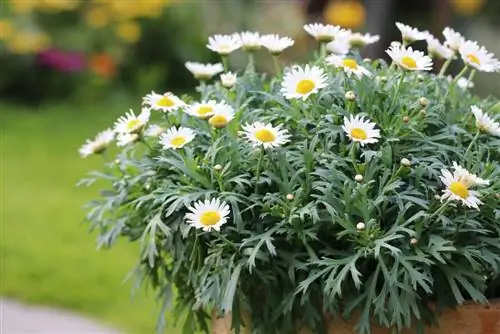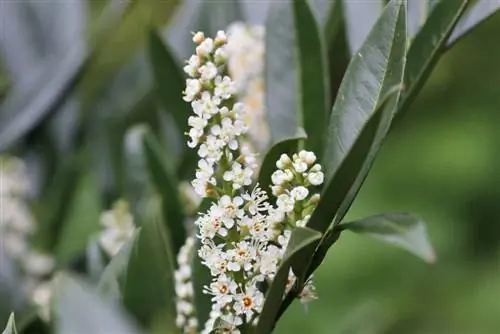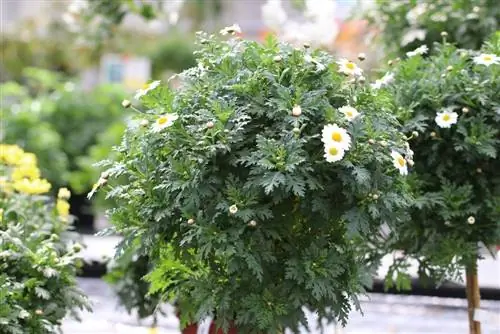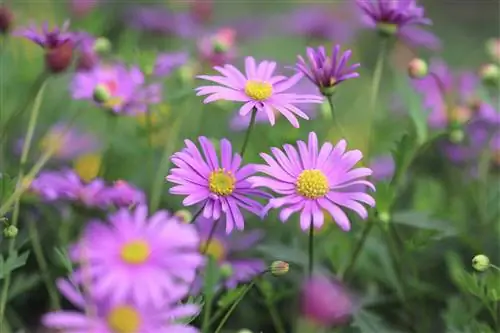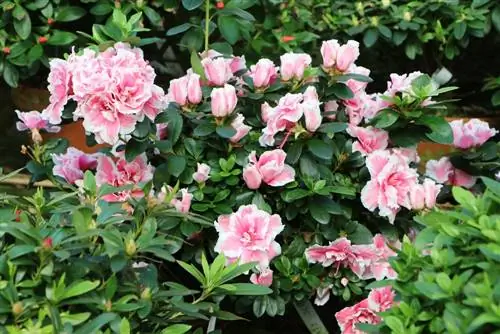- Author admin [email protected].
- Public 2023-12-17 03:39.
- Last modified 2025-01-24 12:45.
Bushy daisies are waiting for us in garden centers just in time for spring. As if the life of this richly flowering plant had to begin anew every year. But that's not the case. There are some specimens that are not frightened by frost. They withdraw their strength into the earth and wait for better days. The remaining species make themselves comfortable in their winter quarters.
Winter hardy daisies outdoors
Some varieties of daisy are hardy. They have thus conquered a permanent place in the garden. They are so well-armed against the cold that they usually come into the new gardening year he althy without any protection. They are only grateful for a protective cover in very cold regions or during bitterly cold winters.
- cover with pine branches
- a layer of leaves also warms
- alternatively, jute or garden fleece make the cold bearable
- Prefer a protected location for new plantings
- as close to a wall as possible
Tip:
Even hardy daisies are only completely safe from severe frost if they are dug out of the garden soil over the winter. After they have spent the uncomfortable time in suitable quarters, they are allowed to spread out again directly in the garden soil in the spring.
Preparatory measures
In autumn, the hardy daisies, which grow outside all the time, are prepared for the approaching winter. The first measure is to stop fertilizing completely at the end of August. This means that the daisy lacks nutrients for new growth. This is by design. New shoots would not have enough time to mature and develop winter hardiness. Furthermore, a main cut is now due.
- cut before the first frosts
- with sharp scissors
- a hand's breadth above the ground
- Collect leaves from the ground and dispose of them
During the winter, the plant retreats into the ground and only sprouts in spring, as soon as the external conditions are more conducive to growth.
Care in the cold season
Winter is the time of absolute standstill. The daisy, also known as the wildflower, no longer grows at all. Therefore, no fertilizer is required. Watering is also almost completely stopped. However, moisture remains an important challenge even in winter. The soil in which the daisy is planted must not be too wet. Combined with cold, it is extremely harmful to the plant. This is precisely why a protected location is helpful. Loose soil that allows water to drain easily also prevents waterlogging. However, if the winter remains without rain for a very long time, the earth becomes dry. The daisy doesn't particularly like that either. In such a case, watering may be moderate even in winter.
Non-hardy daisies in the garden
For frost-sensitive varieties, there are no suitable protective measures that can help them survive the cold outside. They must be dug up for overwintering.
- dig up before the first frost
- planting in pots
- Overwintering with other potted plants
- in safe quarters
- plant again in spring
Overwintering potted daisies

Bushy daisies and daisy stems in large pots are not uncommon. They decorate balconies, terraces or gardens. There you will find the ideal location for the summer. In winter they have to vacate this place if they want to survive the cold unscathed. Most of the specimens that grow in pots are not hardy anyway. That's why overwintering in a protective room is an absolute requirement. Fertilizing should be stopped at the beginning of September, weeks before the move. The growth must come to a h alt and the still fresh shoots must mature in time.
The right time to move
Many warm and sunny days often await us in late autumn. It would be a shame to withhold this from the daisy. Unfortunately it is cold at night and frosts can even set in, which affects the daisy. With a little work this can be mastered.
- Enable being outdoors for as long as possible
- Leave pots outside during the day
- bring in at night due to risk of frost
- “Overnight stay” does not require any special conditions
- the most easily accessible space is optimal
- reduces heavy hauling to a minimum
- However, the final move has to take place around the end of October
- then definitely in a suitable winter quarters
The optimal winter quarters
A frost-free area alone is not good enough for the daisy. She has additional requirements when it comes to her winter home.
- it has to be light
- but without the blazing sun
- with a temperature of 5 to 15 degrees Celsius
It will be too warm for her in most rooms of the house. Only a cool bedroom would be suitable. Garages and windowless basements are cool but also too dark. In it they would form light green and thin shoots that cannot bear flowers. There are therefore only a few accommodation options left for the daisy:
- an unheated winter garden
- Greenhouse
- cool staircase with window
Note:
Daisies are sensitive to temperature fluctuations during their winter rest period. This should be avoided at all costs.
Cutting bush daisies
A heavily pruned bush marguerite tends to dry out in the winter quarters. That's why the main pruning should only take place in spring. Just a light pruning is required just before moving. This only serves to maintain the he alth of the plant. When cutting in autumn, everything that is unnecessary or unnecessary in winter is removed.can harm the plant.
- cut before moving to winter quarters
- remove dried flowers and leaves
- cut away all old flower shoots
- also cut diseased or damaged parts
Cutting daisy stems
Daisy stems are usually cultivated in pots that are only left outdoors during the warm season. These decoratively shaped daisies are not hardy. The main pruning of the trunks is carried out in the fall, immediately before wintering. It is now important to reduce evaporation to a minimum.
- no radical cut required
- cut all flower shoots back to the trunk
- shorten remaining shoots by about a third
- remove sick and injured shoots
- detach dry leaves from the shoots
Note:
After overwintering, a corrective cut can be made in which all disturbing shoots are removed.
Care in winter quarters
You shouldn't neglect the plants even in winter quarters. Although they don't grow, they require a minimum of care to stay alive.
- no more fertilizing
- Water requirement is low
- let it dry until the leaves have fallen off
- water just a little afterwards
- about every 2 to 4 weeks
- the colder the winter quarters, the lower the water requirement
- with soft, low-lime water
- the substrate should not dry out completely
- Spray daisy occasionally with lukewarm water
- Slightly increase watering in spring
Tip:
If the daisy sprouts during the winter, it is a sign of too much water. Reduce the amount of water to prevent premature sprouting.
Pest Control
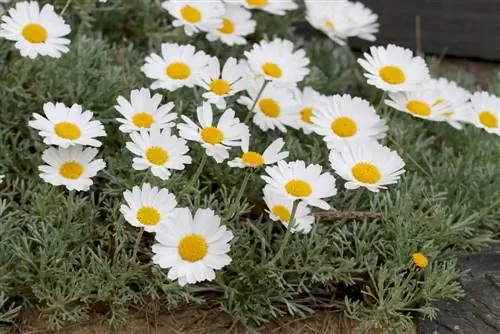
The living conditions of the wild flowers change a lot in winter. The light intensity decreases and the temperatures drop. These challenges make daisies more susceptible to pests. While the daisies are resting, these little creatures can be highly active.
- Plants should not be too close
- Check daisies regularly
- isolate affected plants
- Take control of pests immediately
Tip:
Remove dried leaves from the flower pots as quickly as possible, as they promote rot.
Prevention is of course the best protection. The more optimal the winter quarters are, the less likely a pest infestation will be.
- Provide regular air exchange
- pay attention to frost-free days
- Plants are not allowed to be on the train
- Increase humidity
- with humidifiers or by spraying
End winter rest gently
The optimal overwintering of daisies also includes ending their hibernation period correctly. With the first rays of sunshine, the outdoors beckons, but nothing should be hasty. Before the great freedom comes a time of getting used to it.
- Do not put the bucket out immediately
- slowly move towards warmer temperatures
- change location from March
- slightly warmer, brighter and without direct sun
- water a little more
- fertilize “modestly” for the first time
- It's only safe outside from mid-May
- the time of night frosts is over
Tip:
Now it's time for the main pruning of the bush daisy. Necessary corrections can also be made to stems using scissors.

